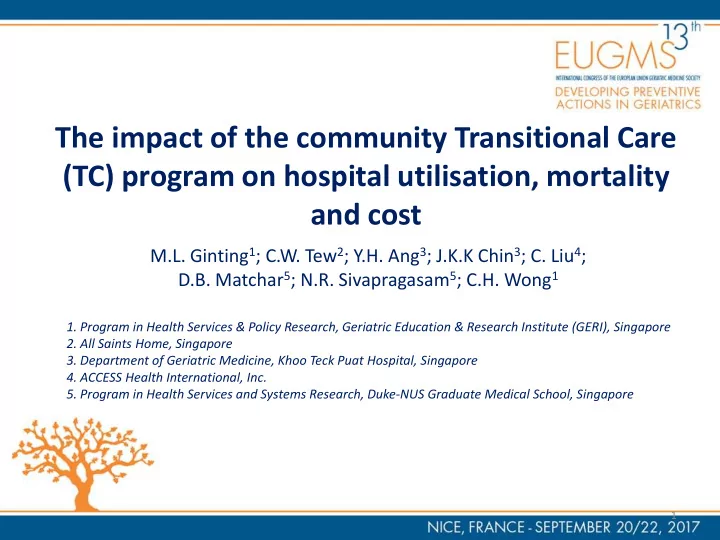

The impact of the community Transitional Care (TC) program on hospital utilisation, mortality and cost M.L. Ginting 1 ; C.W. Tew 2 ; Y.H. Ang 3 ; J.K.K Chin 3 ; C. Liu 4 ; D.B. Matchar 5 ; N.R. Sivapragasam 5 ; C.H. Wong 1 1. Program in Health Services & Policy Research, Geriatric Education & Research Institute (GERI), Singapore 2. All Saints Home, Singapore 3. Department of Geriatric Medicine, Khoo Teck Puat Hospital, Singapore 4. ACCESS Health International, Inc. 5. Program in Health Services and Systems Research, Duke-NUS Graduate Medical School, Singapore 1
CONFLICT OF INTEREST DISCLOSURE I have no potential conflict of interest to report 2
Introduction Aging population with multiple Study Site & Population comorbidity and disability lead to increased hospital utilisation and vulnerable to poor outcomes KTPH during transition from hospital to home. Aim: Singapore – North To evaluate the impact of a 3- month time limited post- hospitalisation transitional care Total population (2014): ~520,730 (TC) program on outcomes of 180 Total population 60 years and above: ~65,040 days post hospital utilisation, mortality and cost . 3
Program Description and Study Flow The TC Program Fulfill at least one of the following: Older adults with geriatric KTPH Study Flow Diagram syndromes All TC referrals Complex medical problems from Apr 12-Mar14 (n=880) Complex nursing needs Socially at-risk Excluded (n=101) Institutionalized (n=17) Post-discharge Referred to other services (n=42) Died (n=16) Care manager Others (n=26) First assessment Perform nursing Eligible (n=779) procedure Chronic diseases management Patient education Accepted TC (n=601) Rejected TC (n=178) Coordinate care Re-admitted or died 7d post- Re-admitted or died 7d discharge (n=65) Inter-disciplinary team Community and home post-discharge (n=16) No match with MOH data (n=3) help services Intervention group (n=553) Control group (n=162) Doctor, PT, OT, speech therapist, MSW 4
Methodology & Results Baseline characteristics Study design: Quasi-experimental with Interventio Controls Variable Difference-in-difference analysis n (n=533) (n=162) Age, mean ± SD 81.9 ± 10.0 80.1 ± 12.0* Data source: retrospective cohort using Female, n (%) 346 (64.9) 109 (67.3) hospital administrative data ADL limitation (0-4), 2.4 ± 1.7 1.7 ± 1.7*** mean ± SD Baseline: 180 days prior index hosp Follow-up: 180 days after index hosp CCI, mean ± SD 6.2 ±2.2 6.0 ±2.5 Utilization pattern, Outcome measures: mean ± SD number of hospitalisation; number of ED Number of hospital 2.0 ± 1.4 2.3 ± 1.7 visits; hospital bed-days; hospitalisation admissions (yes/no); ED visits (yes/no) and re-admission Number of ED visits 2.0 ± 1.5 2.0 ± 1.6 (yes/no); cost and mortality (yes/no) Index LOS 16.0 ± 16.0 13.9 ± 11.9 Covariates: socio-demographic, index Total hospital bed- 24.7 ± 21.1 23.1 ± 18.8 hospital bed-days, ADL, CCI, dementia, level days of care and ward class * p< .05; ** p < .01; *** p < .001 ADL= Activities Daily Living CCI= Charlson Comorbidity Index 5
Adjusted Odd Ratios between Intervention and Controls during Follow-up period Re-admission with similar condition as Mortality (yes/no) index hospitalization (yes/no) 30-Day 30-Day 90-Day 90-Day 180-Day 180-Day 0 0,5 1 1,5 2 2,5 3 3,5 Odds Ratios 0 0,5 1 1,5 2 2,5 Odds Ratios Hospitalisation (yes/no) Emergency department visit (yes/no) 30-Day 30-Day 90-Day 90-Day 180-Day 180-Day 0,5 1 1,5 2 0,5 1 1,5 2 2,5 Odds Ratios Odds Ratios 6
Difference-in-Difference Estimates between Intervention and Controls at 180-day follow-up & Cost Analysis Variable Difference-in-Difference (95% CI) Unadjusted Adjusted Number of hospital admission 0.04 (-0.3 , 0.4) 0.03 (-0.3, 0.4) Number of ED visits 0.1 (-0.3 , 0.5) 0.1 (-0.2, 0.5) Total hospital bed-days -4.1 (-8.6 , 0.5) -4.2 (-8.3 , -0.1)* At 180-day, the intervention had 4.2 less hospital bed-days/patient compared to the controls (adjusted for socio-demographic, CCI, functional status, length of stay, ward class, dementia and level of care) For this cohort of patients, their total cost saving was analysed based on the sum of inpatient and specialist outpatient clinic saving amount minus the total TC cost , whereas: • Inpatient cost saving = adjusted DID hospital bed-days X average inpatient cost/day • TC cost = average visits X manpower normed cost The cost analysis showed an average cost savings of € 836/patient/year among intervention group from the societal perspective , with cost saving for both the patient ( € 529/patient/year) and the government ( € 307/patient/year) 7
Discussion & Conclusion Although not statistically significant, patients in intervention group had higher odds of visiting ED, but it did not translate to higher odds of hospitalisation. Intervention group had a shorter length of stay; which could be due to early identification of medical, functional and social problems and early treatment in the community. TC is able to reduce hospital bed-days and cost among older patients with complex care needs. 8
THANK YOU 9
Recommend
More recommend